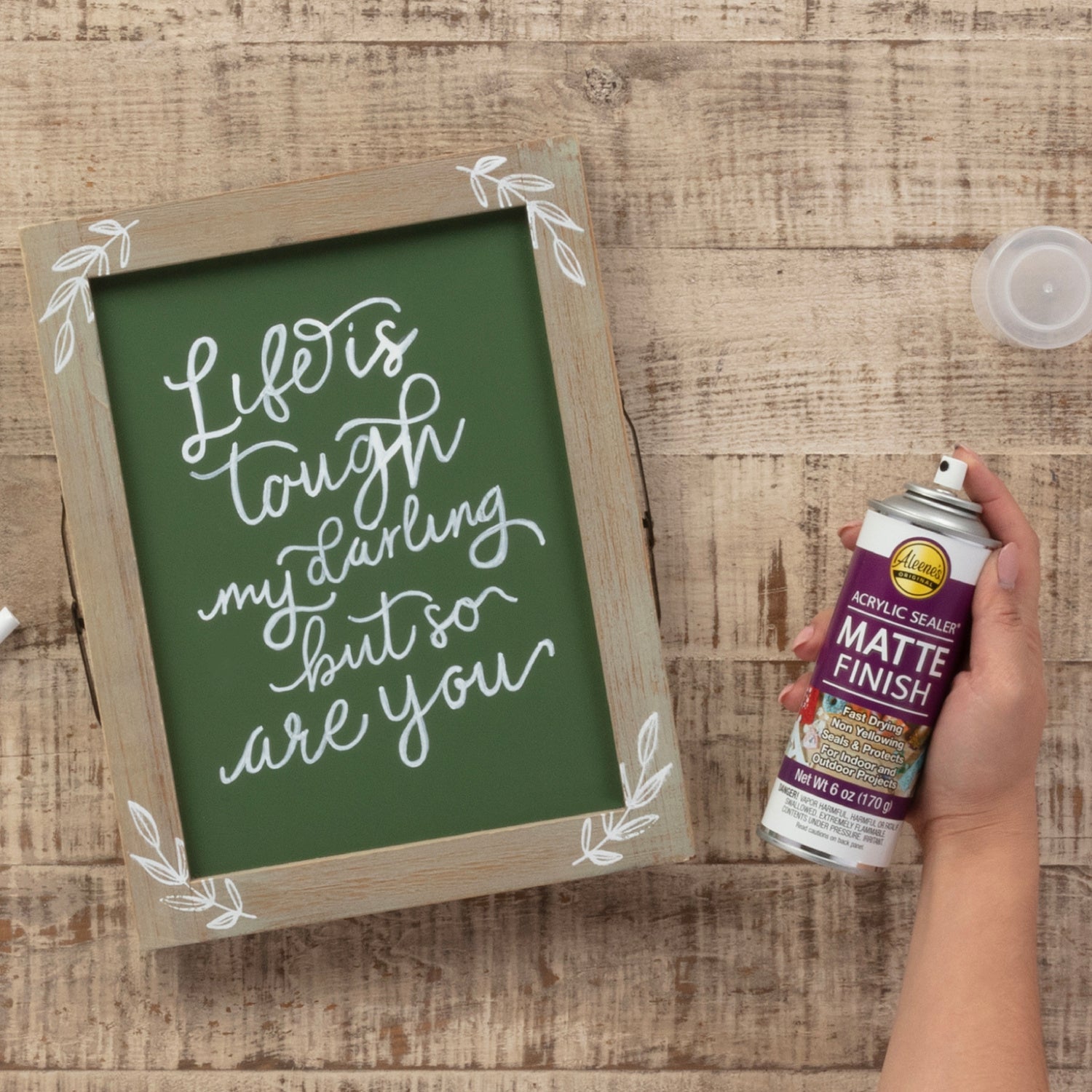Frequently Asked Questions

If you can't find the answer, email:
Wondering how to get the most out of your Aleene’s glue? Use the search bar to find tips and techniques in our frequently asked questions.
Order & Shipping
To find an International Distributor, please contact us at info@aleenes.com. We can connect you, based on your country.
For wholesale, please visit shop.ilovetocreate.com
Glue Types & Products
Aleene's Tacky Glue is nontoxic and safe for classroom, home, or office use. Make sure to check the label of any glue before using, as all products containing toxic materials are required to print a caution message on all labels.
School glue is a nontoxic, kid-friendly adhesive that is safe for use in the classroom. School glue is often a white glue - also called a PVA Glue or polyvinyl acetate glue - and is nontoxic, odorless, and acid-free.
Yes, Aleene's makes waterproof sealants. Check out Aleene's Spray Acrylic Sealers in matte, gloss, and pearlescent finishes.
Glue Application
Drying time varies depending on the glue formulation, the temperature and humidity, and the amount of glue used. Generally, the thinner the application of glue and the warmer and dryer the climate, the faster the glue will dry. Heat is the most efficient method for getting glue to dry quickly. You can use a blow dryer, a heat lamp, a fan or other accelerator products to help speed up the glue drying process.
Glue doesn't always have to be applied directly from the bottle; depending on the project and surfaces, sometimes using other tools is better, depending on your goal. Generally, you'll want to use disposable tools that can be thrown away after use since glue can damage the tool or brush. We recommend the following tools for applying glue: sea sponges, cosmetic sponges, toothpicks, inexpensive bristle brushes/paintbrushes, foam brushes, cotton swabs.
There are many reasons why glue might not work as it's supposed to: The surfaces you are trying to glue are dirty or greasy, thus preventing the glue from properly bonding to the surfaces. Make sure the items are clean from visible dirt and debris. PVA and solvent glues work by sinking into the surfaces of the articles being glued and forming a physical bond to lock the pieces together. You might be using the wrong glue for the surfaces you are gluing; check the glue label to see what surfaces it's formulated to adhere to. The glue might need to be applied differently. Make sure to read all instructions before using.
- Apply a layer of glue to both substrates to be glued. Do not immediately press together; instead wait about 5 minutes for the glue to tack up so it’s not as slippery. Press the items together. Secure with tape, clamps or clothespins until the glue dries completely.
Glue residue happens. Whether using a Spray Adhesive or if you apply too much glue before pressing your substrates together. Here are a couple of quick ways to address this concern. If the glue is still wet, use a dry paper towel or Q-tip to remove most of the excess, then clean away with a damp, soapy cloth. If the glue has dried, you can try peeling or rubbing it away by carefully scraping it from the surface with a knife or razor blade or using a glue remover product like Goo Gone. All Tacky and water-based adhesives can be removed with an all-natural, biodegradable citrus-based cleaner. For solvent-based adhesives, we recommend trying acetone (found in nail polish remover), rubbing alcohol (85% or higher), or mineral spirits.
Cleanup & Care Tips
Aleene's Insta-Fuse Fabric Fusion is the only product in the line that is dry cleanable. Chemicals used in most dry cleaning processes will weaken or dissolve most other glues and weaken the bond.
Techniques
Temporary glue can be used as a resistor on fabric. Note: Permanent fabric glue will dry permanently on the fabric and should not be used. Here is how to use glue as a resist:
- Apply the glue to the fabric in the design of your choice.
- Allow the glue to dry completely on the fabric, becoming rigid and clear.
- Paint or dye the fabric in the colors of your choice.
- Allow the fabric to dry completely after applying the dye/paint.
- Soak the fabric in warm water for 20 to 30 minutes to soften the glue.
- Wash the fabric by hand or machine in warm, soapy water to remove the remaining glue.
Tip: Aleene's Clear Gel Tacky Glue makes a great resist on fabric.
Yes. Aleene's has several clay recipes using Original Tacky Glue and everyday household items. Here is how to make clay with glue and bread:
- Remove the crust from a slice of bread (white bread is suggested for best results when coloring the clay).
- Tear the bread slice into small pieces and place in a disposable plastic bag, then add 1 tablespoon of Tacky Glue.
- Add a few drops of acrylic paint to color the clay if desired. Clay can also be painted after drying. Knead the bread and glue within the bag until thoroughly mixed and clay forms.
- Remove the clay from the bag and knead until fully formed. Note: if the mixture is too runny, add more bread pieces in small amounts. Use clay to make the desired item, then let dry overnight.
- Paint with acrylic paint if desired, let it dry, then seal it with your favorite Aleene's Acrylic Sealer.
Aleene's Original Tacky Glue can create crackled effects on surfaces. Here is how to create a crack effect using glue:
- Paint the object with a base coat of acrylic paint. Let dry.
- Brush an abundant layer of Tacky Glue over the dried paint in the areas you want to crackle. Let the glue set until firm and tacky but not completely dry.
- While the layer of glue is still sticky, brush the same color of paint or a contrasting color over the glue, brushing only once instead of back and forth, as that could hinder the crackling process.
- As the paint and glue dry, they will naturally crackle. Let dry completely.
- Protect your project with your favorite Aleene's Acrylic Sealer.
Here is how to make cheesecloth ghosts with Aleene's Fabric Stiffener glue:
- You can form ghosts with balloons, foam balls, or other circular dimensional objects. If you are using a non-disposable object, you can protect the surface with plastic wrap or a plastic bag.
- Cut desired swatch size from cheesecloth.
- Pour Fabric Stiffener into a disposable bowl, and wearing gloves, dip cheesecloth swatches in the liquid to saturate. Wring out the excess.
- Drape saturated cheesecloth over circular object and let dry.
- Remove from form.
- Glue on facial features or use paint to create. Fabric Stiffener can also be thinned with water up to a 50/50 ratio and tinted with acrylic paint.
DIY & Repair
It depends on the surfaces you are gluing. Check glue labels to verify what surfaces they are formulated to work best on (ex. wood, plastic, glass, porcelain). In general, you want a glue that is formulated to dry permanently with a strong hold. For outdoor items, we recommend adhesives that are weather proof and UV proof.
Aleene's makes several adhesives that are great for gluing plastic to wood. Aleene's DIY Craft Super Glue Gel is an industrial-strength glue that bonds in seconds and can be used on a variety of heavy duty surfaces, including plastic and wood. Another heavy duty glue that you can trust for gluing plastic to wood is The Ultimate Multi-Surface Adhesive.
We recommend using Aleene's DIY Craft Super Glue Gel to glue rubber to plastic. This industrial-strength, all-purpose glue works on a variety of heavy duty surfaces, such as rubber, plastic, glass, metal, fiberglass and more.
Fabric & Embellishment Glue
The best fabric glue for patches with textile backings is Permanent Fabric Glue. Fabric Fusion will also work well for denim fabric repair but will have a slightly stiffer “hand.”
The water-based fabric glues, such as Fabric Fusion, OK to Wash-It, Permanent Fabric Glue, etc., will wash out easily with a water rinse or one wash cycle if the glue is still wet.
The solvent-based fabric glues, such as Super Fabric Adhesive and Quick Dry Fabric Fusion, are more difficult to wash out and will require using a solvent such as acetone to remove the wet glue. Always test before use.
The heat-activated Insta-Fuse Fabric Fusion can be washed off very easily with water before heat set.
The dry time for fabric glue depends on the application thickness. Waiting a minimum of 72 hours for all the fabric glues is recommended before laundering.
Most of the water-based fabric glues, such as Fabric Fusion, OK to Wash-It, and Permanent Fabric Glue, will dry within an hour for thin applications. Thicker applications of the water-based fabric glues will require up to 24 hours to dry.
The solvent-based fabric glues will dry quicker. Super Fabric Adhesive dries within 30-40 minutes and Quick Dry Fabric Fusion will dry within 3 minutes.
For instant hold with no dry time, use the heat-activated Insta-Fuse Fabric Fusion.
Yes. The fabric glues such as OK to Wash-It, Permanent Fabric Glue, and Fabric Fusion work very well as craft glues, and have a non-acidic pH which is a good feature for paper crafts. The fabric glues also dry more flexible than the usual craft glues such as Tacky Glue and Clear Gel Tacky.
Vinyl is a difficult substrate to adhere using fabric glues. Super Fabric Adhesive has moderate adhesion, but can peel up when not applied correctly.
Yes. The fabric glues are a good alternative to sewing but the crafter is advised to test first to make sure the “hand” and amount of soak-through is acceptable. Our fabric glues remain permanent through repeated washings and won’t yellow or lose adhesion over time.
Currently, most fabric glues contain synthetic ingredients, and truly eco-friendly options are limited. However, there are some alternatives, like water-based fabric glues, that limit the use of petroleum-based solvents that make them more sustainable options. If this is important to you, consider Fabric Fusion, OK to Wash-It, Permanent Fabric Glue, etc.
An embellishment glue is a fabric glue that is used to decorate garments and home décor items. Fabric glues are a great option for embellishing because of their flexible, permanent bond that keeps items in place. Typical embellishments include rhinestones, beads, pom poms, trims, sequins, glitter, appliqués, etc.
Yes, glitter can be adhered to fabric with fabric glue. To add glitter to fabric with fabric glue, squeeze the glue directly from the bottle or use a paint brush to apply designs onto fabric with or without a stencil. While the glue is still wet, sprinkle on a generous amount of glitter and wait for the glue to dry. After the glue is dry, shake off all excess glitter. Glitters generally have good adhesion and longevity on fabric with all Aleene’s fabric glues.
The best glue for applying rhinestones to a variety of surfaces is Rhinestone Adhesive. It is formulated to dry clear, flexible, and permanent, and won’t damage or tarnish embellishments. Water-based fabric glues will also adhere strongly without any damaging effects to rhinestones. The other recommended rhinestone glues are Jewel-It, OK to Wash-It, and Permanent Fabric Glue.
The best rhinestone glue for fabrics is Rhinestone Adhesive. It is formulated to dry clear, flexible, and permanent, and won’t damage or tarnish embellishments. Liquid Fusion Performance adhesive is another great option, providing the strongest rhinestone to fabric bond strength of the glues.
The water-based fabric glues such as Fabric Fusion, Permanent Fabric Glue, and OK to Wash-It are the safest fabric glues with the lowest toxicity as they are non-carcinogenic, do not contain harsh solvents, and are nonflammable.
Soaking in acetone can remove some dried fabric glues but may not remove all the adhesive.
All our permanent fabric glues, including Leather & Suede Glue, are water-resistant. They are not considered waterproof. Our temporary fabric glues, such as No-Sew and Temporary Fabric Glue Sticks, are designed to be washed out and therefore are not water-resistant. These adhesives are ideal for temporary fixes or for use with sewing machines.
The best fabric glue for your project depends on what the project is. Always test fabric glues in an inconspicuous location before applying to your project.
· Velvet:
The best fabric glues for velvet are Fabric Fusion, Permanent Fabric Glue, OK to Wash-It, Quick Dry Fabric Fusion, and Super Fabric. Quick Dry Fabric Fusion will have the softest hand and the least amount of bleed-through. On dark fabrics, any of these glues will work well.
· Lampshades:
The best fabric glue for lampshades are Fabric Fusion, Rhinestone Adhesive, Permanent Fabric Glue, OK to Wash-It, and Fabric Fusion Tape. These fabric glues have been tested up to 160 °F so they are able to withstand hot temperatures and are nonflammable. The Fabric Fusion Tape will have the most invisible look and will adhere strongly to plastic lampshade liners.
· Polyester:
The best fabric glues for polyester are Fabric Fusion, Permanent Fabric Glue, OK to Wash-It, Quick Dry Fabric Fusion, and Super Fabric. Fabric Fusion Tape will also work well if the fabric is smooth, but is not recommended for textured polyester.
· Textured Nylon:
The best fabric glues for textured nylon are Fabric Fusion, Permanent Fabric Glue, OK to Wash-It. Test first for soak-through.
· Nylon windbreaker, ski-jacket materials:
The best fabric glue for nylon windbreaker and ski-jacket materials is Fabric Fusion Tape. Use a double layer of tape for stronger adhesion.
· Spandex:
The best fabric glue for spandex is Flexible Stretchable, which is specifically formulated for stretchy fabrics. Permanent Fabric Glue or the Quick Dry Fabric Fusion will also stretch slightly with the spandex.
· Satin:
The best fabric glues for satin are Quick Dry Fabric Fusion or the Fabric Fusion Tape. Satin has a higher potential for wet soak, so test before use.
· Felt:
The best fabric glues for felt are Quick Dry Fabric Fusion, Permanent Fabric Glue, OK to Wash-It, Super Fabric. A moderately thick layer of glue should be used to fill in the textured gaps in the fabric for the strongest bonds. Fast Grab Tacky Glue or Felt and Foam Tacky Glue are our best craft glues for non-washable felt craft projects.
· Leather, porous backside:
The best leather glues to use on the porous backside are Leather & Suede Glue, Fabric Fusion, or Liquid Fusion.
· Leather, smooth top side:
The best leather glue for the smooth top side is Jewelry & Metal Glue.
Yes. Waiting a minimum of 72 hours for all the fabric glues is recommended before laundering. Fabric glues with temporary hold, like No-Sew, are not machine washable. You can also refer to the back of the packaging for dry times and laundering instructions.
The water-based fabric glues may darken certain lightweight and delicate fabrics, such as polyester satin ribbon. The solvent-based fabric glues may cause some color-bleeding of some dyed items. It is recommended to test fabric glues in an inconspicuous location before applying to your project.










